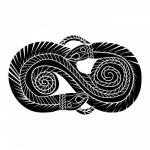Odontological traitsAnthropological odontology deals with varying traits of teeth. Odontological traits are racial peculiarities,
divided into so-called ”eastern” and ”western” traits. The distribution frequency of eastern traits increases in
east direction and attains its maximum in Mongoloid populations; the frequency of western traits increases in
west direction. Complexes of traits characterising different odontological types have been established (Зубов
1979). The types established mainly in East European (former SU) regions are: the southern gracile
odontological type in the Caucasus; the Central European type occurring mainly in Lithuania, Byelorussia, the
Ukraine, in Central and Southern Russia; the northern gracile type, which is mainly spread among Finno-Ugric
peoples, but also occurs among Latvians and northern Russians; and the North European relic type, which is
also typical of Finno-Ugrians, but has been recorded among eastern Latvians, too.
Galina Sarap (1994) has studied the distribution of odontological traits and odontological types among
Estonians. According to her studies one can find the following odontological types on the territory of Estonia:
1) The Central European type on western islands and in West Estonia, and in some parts of northern, eastern
and southern Estonia. This type is characterised by a low frequency of eastern traits and a high frequency of
western traits, and by strong reduction of lower molars. It is a Baltic variant of the Central European
odontological type. The majority of Lithuanians, western Latvians, Russians from Central Russia and some
groups of Swedes are representatives of the classical form of that type. 2) The northern gracile type is spread in
central and northeast parts of Estonia, and in some parts of North, South-West and South-East Estonia. The
type is characterised by a high frequency of eastern and western features occurring in parallel, and a strong
reduction of lower molars. That type is common among southwestern and northwestern Finns, Karelians and
Maris. 3) The influence of the North European relic type is noticeable in North, East and South Estonia. In a
pure form, this type occurs among northeastern Finns, Lapps and Komis, in a mixed form also among eastern
Latvians. A peculiarity of this type lies in the coexistence of western features in a moderate frequency, and of
some typical eastern features in a high frequency.
A conspicuous peculiarity of the northern gracile type is well expressed in the quantity of ISC (Index of the
Specific Combination). Usually, ISC does not exceed 150 (neither in Europoids nor in Mongoloids), but it is
always larger among the representatives of the northern gracile type, attaining the value 200–300 and even
higher.
The regional distribution of ISC indicator in Estonia is rather interesting (Sarap, 1994:232). North-East
Estonia is especially prominent with ISC (502). Very high values of ISC (300–500) also occur in several South
Estonian groups. Somewhat lower, but yet comparatively high values of ISC (220–290) have been recorded in
Central Estonia. In all these regions, in G. Sarapґs opinion, predominates the northern gracile type, however,
with an addition of other types. Especially low are ISC values in the dialect regions of the West Islands, of
West Estonia and East Estonia (accordingly, 72, 91 and 81). The two former regions correspond to the
distribution area of the Central European type, whereas in the latter, besides the Central European
odontological type, there is also a certain influence of the North European relic type observed. So the
odontological data also show a considerable heterogeneity of Estonians, in which typical Finno-Ugrian and
some westward complexes of traits have been mixed.
The Estonian odontological complexes have been compared with those of the Baltic states, Finland and
other neighbouring territories using the traditional selection of eastern and western odontological traits.
According to that Estonians are mostly close to Latvians, Lithuanians, Trans-Carpathian Hungarians, western
Swedes and northern Russians. In general, the Central European odontological type dominates in all of them.
Northeast Estonians are situated close to northwest and southwest Finns. In these groups predominates the
northern gracile type. The Estonian regions (East and South-East Estonia) influenced by the North European
relic type are situated comparatively close to the other Estonian regions, but have a somewhat peculiar
inclination towards the classical representatives of the North European relic type, the Lapps, and the other
104
ethnic groups influenced by the North European relic type – eastern Latvians, southeastern Finns, Karelians
and Vepses.
In Latvia, according to R. Gravere (Гравере 1987), mainly the same odontological types are represented
which occur in Estonia – the Central European and the northern gracile type. Besides those, the North
European relic type is also found in eastern Latvia, mainly on the territory of the East-Baltic anthropological
type and it seems to be connected with the Balto-Finnic substratum. The northern gracile type is spread on a
quite wide territory in Latvia, also on the territory of the narrow-faced variant of the West-Baltic
anthropological type. That covers districts once inhabited by Livonians and South Estonians, extending in
places far off in southern direction. The occurrence of the northern gracile type traits among other peoples is a
clear evidence that in these regions Finnic peoples have mixed with the other ethnic groups. Such a situation
occurs in northwestern provinces of Russia. The distribution of odontological types in North-East Europe is
illustrated in Figure 5

Fig. 5. Odontological types of peoples in North-East Europe.
1 – Central European type, 2 – North European relic type, 3 – Central European
type with the component of North European relic, 4 – Northern gracile type, 5 –
North European relic type with the component of northern gracile complex, 6 –
odontological complex with all 3 odontological types.
 Вход
Вход Зарегистрироваться
Зарегистрироваться





 Наверх
Наверх










